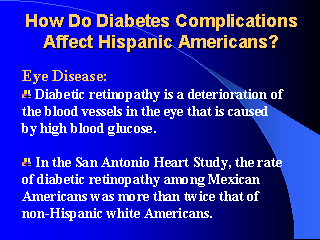|
|
|
|
front |1 |2 |3 |4 |5 |6 |7 |8 |9 |10 |11 |12 |13 |14 |15 |16 |17 |18 |19 |20 |21 |22 |23 |24 |25 |26 |27 |28 |29 |30 |31 |32 |33 |34 |review |
 |
Sight-threatening retinopathy is a common complication of diabetes. Some 40,000
patients per year are estimated to develop proliferative retinopathy with high
risk characteristics, and 95,000 per year are estimated to develop macular
edema. Clinical trials published more than a decade ago proved that
photocoagulation significantly reduces the risk of blindness. Sadly, less than
half of all patients with diabetes report having seen an ophthalmologist or
having had a dilated eye examination within the preceding year. Diabetic retinopathy is a highly specific vascular complication of both Type 1 and Type 2 diabetes. The prevalence of retinopathy is strongly related to the duration of diabetes. After 20 years of diabetes, nearly all patients with Type 1 diabetes and >60% of patients with Type 2 diabetes have some degree of retinopathy. Diabetic retinopathy poses a serious threat to vision. Overall, diabetic retinopathy is estimated to be the most frequent cause of new cases of blindness among adults aged 20-74 years. In general, the progression of retinopathy is orderly, advancing from mild nonproliferative abnormalities, characterized by increased vascular permeability, to moderate and severe nonproliferative diabetic retinopathy (NPDR), characterized by vascular closure, to proliferative diabetic retinopathy (PDR), characterized by the growth of new blood vessels on the retina and posterior surface of the vitreous. Pregnancy, puberty, and cataract surgery can accelerate these changes. The Early Treatment of Diabetic Retinopathy Study (ETDRS) determined that laser treatment is beneficial in certain patients with PDR and macular edema before visual loss has occurred. No medications have been identified that help. A comprehensive program to reduce diabetes-related blindness should include screening and treatment of retinopathy, and diabetes treatment with the goal of normal glycemia. A study of the prevalence of retinopathy (eye disease) in the San Antonio Heart Study Mexican-American population revealed that early age of diagnosis, long duration of Type 2 DM, severe glycemia, lower diastolic blood pressure, and the use of oral hypoglycemic medication were more prevalent among subjects experiencing retinopathy. It was found that Mexican-Americans had a higher risk of retinopathy and of development of severe retinopathy than Non-Hispanic Whites. |